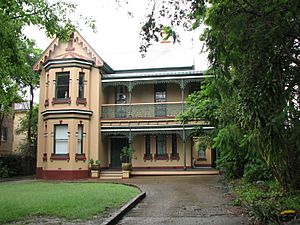Camden, Rosehill facts for kids
Quick facts for kids Camden |
|
|---|---|

Camden, 60 Prospect Street, Rosehill, New South Wales
|
|
| Location | 60 Prospect Street, Rosehill, City of Parramatta, New South Wales, Australia |
| Built | 1883 |
| Official name: Camden | |
| Type | State heritage (complex / group) |
| Designated | 2 April 1999 |
| Reference no. | 250 |
| Type | House |
| Category | Residential buildings (private) |
| Lua error in Module:Location_map at line 420: attempt to index field 'wikibase' (a nil value). | |
Camden is a special old house located at 60 Prospect Street in Rosehill, Australia. It was built way back in 1883. This house is so important that it was added to the New South Wales State Heritage Register on 2 April 1999. This means it's protected because of its history and unique features.
Contents
Discovering Camden's Past
The land where Camden stands was first sold in February 1883. This happened during an auction of parts of Elizabeth Farm, which was a very old and important property.
Early Owners and Names
In 1888, there were only a few houses on Prospect Street. But by 1889, Camden was one of five houses there. It was built by Thomas S. Staff. A few years later, in 1891, the house was given to James S. Staff, who lived there until 1904.
After the Staff family, other people lived in the house. John G. Cousins and Robert Howarth were some of them. In 1907, Robert Howarth gave the house the name "Chelsea." Later, David Irons moved in during 1908, and Pascoe E. Pearce followed in 1911.
In 1913, "Chelsea" went back to the Staff family. Sydney N. Staff took over and, in 1916, he gave the house a funny new name: "I-dun-no." He lived there until 1919.
More families lived in the house after that. William Turnock lived there from 1921 to 1924. Spencer W. Bates lived there from 1925 to 1929. Percival Whiteside was there until at least 1932 or 1933.
Camden's Later Life
According to the families who first owned the house, it later became a private nursing home. This is when it got its current name, "Camden."
At some point, the house was divided into two separate apartments. The original staircase inside was removed. A new staircase was built outside so people could reach the top apartment. The Craft family lived there between 1940 and 1952. Around 1953, the house was bought for about 2,000 pounds.
A kitchen and bathroom were added to the house around 1970.
What Camden Looks Like
Camden is a two-story house built in the Victorian Italianate style. This means it has a grand, fancy look, like buildings you might see in Italy.
Key Features of the House
The house is made of brickwork covered in stucco, which is a type of plaster. Its roof is made of gabled corrugated iron. One part of the house has a three-sided bay window. This section has decorative stucco bands and fancy carvings around the windows. It also has large, detailed wooden decorations called bargeboards.
A verandah wraps around the northern and western sides of the house. It has pretty cast iron columns and delicate lace balustrades. The verandah roof is bullnose-shaped and made of corrugated iron. The floors are made of timber. The house is surrounded by beautiful gardens and trees.
Inside and Out
Even though the house was split into two apartments, many of its original features are still there. The old wooden doors, window frames, and fireplaces are mostly untouched. Only small changes have been made over the years.
In 2003, some parts of the house needed minor repairs, like cracked plaster ceilings and brickwork. But overall, the house was in good shape and had been well cared for.
Why Camden is Important
Camden is considered one of the best examples of a mid-Victorian villa house in the Parramatta area. There are only six other buildings like it from the same time period and with a similar architectural style in the whole Parramatta region.
Camden was officially listed on the New South Wales State Heritage Register on 2 April 1999. This happened because it met certain important rules.
Showing History and Style
- It shows how history unfolded in New South Wales: Camden is important because it helps us understand the past. It shows us how people lived and how buildings were designed during its time.
- It represents a type of important building: This house is a great example of a Victorian villa. It helps us see the main features of this kind of building from that era.

